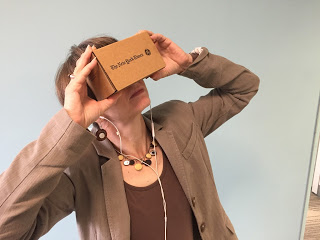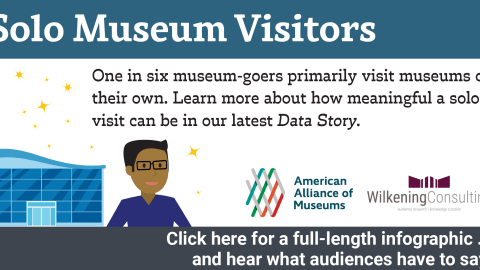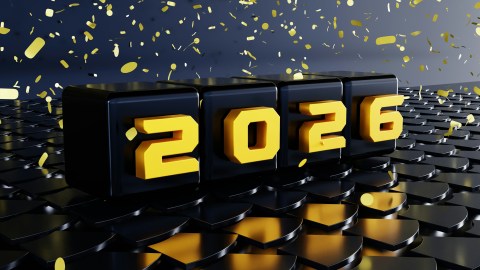
Lookie what I found bundled in with my Sunday newspaper:
It’s a free Google Cardboard device from the New York Times. I promptly downloaded the app and started watching the 3-D, immersive short films they have already released: a profile of three children living in refugee camp; a short documentary on the making of artist JR’s “Walking New York” installation; and two sponsored content films—a fiction adventure from Mini and an animated look at bio-mimetic industrial design from GE. (If you don’t have a VR headset, you can view 2D versions on your computer monitor.) The NYT says it is “committed to VR storytelling” and promises to deliver more content soon.
This is a brilliant move to extend the reach and impact of an industry (investigative journalism) struggling to win new audiences and find stable financial models. And I think it is an important example for museums looking for a new way to deliver content, cultivate member relationships and deepen engagement.
I’ve pointed out in the past how museums could harness 3D printers in a similar way: create a member benefit that provides the opportunity to buy a printer at cost (or below cost) to members and follow up with a members-only “3D scan of the month.” (This also opens up opportunities for co-creation: members could vote on their favorite museum object to join the 3D queue; the museum could hold scanning and printing classes to help people create scans to add to the roster of 3D offerings.) The hitch here is that 3D printers are still pretty pricey (from several hundred to several thousand dollars, depending on quality, speed, reliability) and have a steep learning curve for use. Also—the printer is pretty much only good for one thing.
There are work arounds to the costs (encourage people to use printers increasingly available at local copy shops, send scans to online firms for production, hold maker workshops where people can use the museums’ own printers). But still, the adoption barrier is pretty high, even though the costs to the museum to produce and distribute the scans can be pretty low. Some very good tools that can be used to create 3D scans are free or low cost, and many use the camera on a smart phone or tablet. (For more sophisticated scans, the supporting tech can be a lot pricier of course.)
Cardboard flips the economics of pushing out engaging, multisensory digital content. Nearly two-thirds of Americans own smartphones, and the NYT VR app is free. That figure is probably even higher among NYT subscribers, and museum members. Even if you aren’t a NYT subscriber, you can buy Google Cardboard from a number of vendors (Google open sourced the specs) for under $10. That makes for a really low barrier to consumption. On the other hand, producing the content is expensive, and many museums will need to look for partners (financial, technical) just as the NYT did to pull this off.
Consider the potential pay back. An article in Wired yesterday called virtual reality an “empathy engine” and having watched the films, I agree they grip the heart (and in some vertiginous moments, the stomach) in ways the print stories do not.
Here’s some museum-based VR experiences I would value:
- Sneak peeks of exhibits about to open (which would also encourage me to come see the real thing!)
- Behind-the-scenes looks at the cool happenings most people never get to see: uncrating a new acquisition; conserving a painting; rigging and moving a big specimen or sculpture; an on-site look at field work (archaeology, dino digs, biological exploration)
- “Sitting in” on a prototyping session to see how exhibit elements are designed and tested
I think it would even be a great medium for an annual report from the director—looking her in the eye (and snooping around her office), while I get the inside skinny on what’s up at the museum in the coming year.
The big take away is this: museums should keep an eye on emerging technology—Google Cardboard, 3D printing, and soon sophisticated augmented reality equipment like Hololens and Magic Leap—and figure out how to use these devices to insert themselves more deeply into people’s lives. Let big companies spend the big bucks developing, testing, marketing and deploying the underlying technology—our opportunity is to use them for compelling storytelling, and as ways of expanding our reach beyond the museum’s walls.










Last weekend we did our first public "stress test" of VR experiences at The Museum of Flight in Seattle. We are partnering with Valve on their SteamVR platform, which uses the HTC VIVE headset. The test run went really well, and over the course of three days we had hundreds of people walking around the surface of a virtual Mars, and on Comet 67P.
We've been playing around with applications for both public engagement and for informing the exhibit design process. When dealing with large artifacts like aircraft, it is really helpful to be able to get a sense of human scale in VR before moving planes around.
Thanks for sharing about The Museum of Flight's VR project, Geoff. So great that you found a local partner (Valve) to work with. I'd be interested to know–did them museum reach out to Valve, or did they approach you? I hope that companies realize what great partners museums are for testing this kind of tech, but more often than not I find that museums have to make the first move.
Valve actually reached out to us. Their system is looking to go live in Q1 of 2016, and they need unique content. They gave us some dev kits and access to their existing VR experiences in exchange for access to some of the unique spaces (eg aircraft and spacecraft interiors) found at the museum. We will also have access to any content they create from museum assets.
"Let big companies spend the big bucks developing, testing, marketing and deploying the underlying technology—our opportunity is to use them for compelling storytelling, and as ways of expanding our reach beyond the museum’s walls."
Yes!! I'm drawn to projects like the Balboa Park Giskin Anomaly cell phone adventure, because that project creatively harnessed a technology that is already widely-used (Pew says 90 percent of Americans have a cell phone). I think this approach is especially important for small museums like mine (Museum of Durham History). Investing in cutting-edge technologies with many unknowns and a limited audience of early-adopters is not wise for us. But we can be experimenting with creative uses for existing technologies, while keeping an eye on emerging tech until more is known about how it works and, most importantly, who is using it.
Speaking of history museums (where Katie is coming from), historic sites are definitely another environment ripe for this kind of VR. It would be a great way to overlay historical imagery, reenactments and event recreations, past features that no longer exist, etc. on the very place where it all happened. I could see our Historic Fort Snelling (in Minnesota), for example (a place with a multi-faceted and complicated story), showing the pre-European-era presence of Dakota Indians, Dred Scott walking around in the 19th century, and so forth.